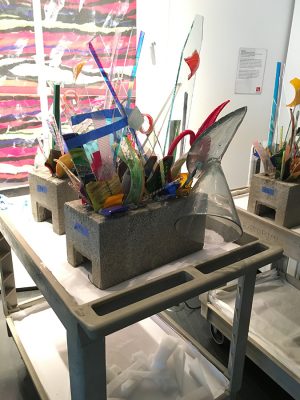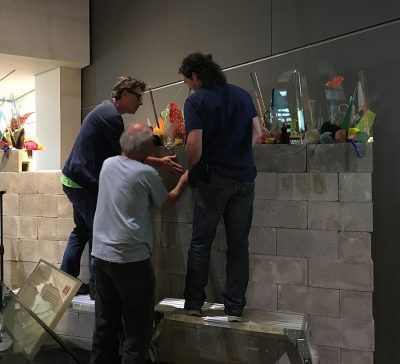Artist Buster Simpson has been transforming public spaces for the last 40+ years. In Seattle, he has created work that makes statements about gentrification, the environment, human rights, and the irony of art itself.
In 2007, The Corning Museum of Glass acquired Simpson’s Shard Cornice, which was first exhibited in 2000 at the Henry Art Gallery at the University of Washington. Simpson is in Corning this week to assist with the installation of Shard Cornice and to give a presentation at the GAS conference. We managed to pull him aside for a brief Q&A.

Shard Cornice, 2003
Gift of Dale and Doug Anderson, Kate Elliott, and Elisabeth
and Norman Sandler
© Lewis C. “Buster” Simpson
Describe Shard Cornice.
Shard Cornice is a baroque attempt at homeland security. It draws from the cultural history of many places in the world where people put sharp, pointy things along the perimeter wall of their property to keep people from scaling over the fence. Would we consider this more attractive than razor wire? It’s just as effective; it’s probably more attractive. Maybe this is a new market for the glass artist to venture and turn their waste products into a defensive homeland security device.
You initially designed Shard Cornice in 2000 for the Henry Art Gallery. How did that come about?
Actually, the first time it was shown was at a national conference in Seattle. We did a glass card house. It was not held up by glue, but by simple friction, just like you would build a paper card house. It was about 10 feet high and used large sheets of spectrum glass, thin glass. We built the piece in the hot shop at the Pratt Fine Arts Center. We handed out stones to everyone in the audience. We had two trumpeteers who had these two gorgeous horns; they tried to find the frequency that might resonate and cause the glass to fall. Eventually, they did and the glass card house tumbled down. Everyone who was holding onto their rocks then lobbed them, almost as an offering, on top of this pile of shards. We then took the shards and put them into fresh concrete. We basically created a Shard Cornice at Pratt. This piece was shown at the Henry Art Gallery and at the Bellevue Arts Museum. Both were installed outside. I hope, eventually, Corning will find a suitable wall on the exterior of their museum where this Shard Cornice could be installed, so that it’s actually out there working its intended purpose.
You’ve described glass as a medium both fragile and powerful. Can you elaborate on that?
It’s incredible as far as compression, it is very strong material. Glass is fragile, liquid, and strong. It’s like human nature. Like I said before, it might make a good replacement for razor wire.
- Bricks for Shard Cornice waiting to be placed.
- Delicately placing bricks for Shard Cornice.
A lot of your work has social and environmental implications. How does Shard Cornice fit into your body of work?
A lot of my work is about healing, but I think that an artist’s role is to seek that edge—no pun intended, considering all the sharp edges on this piece. It does have an undertone about the disparity between the rich and the poor, the have and the have-nots. You can look at that in a number of ways—it could be environmental. Consumption is an unsustainable habit we have; all of our landfills will testify to that. I think we all need to think more about what we consume. There’s a graffiti that I love, maybe we’ll paint that on the side of this piece: “Your urge to consume terrorizes you.”
Learn more about Buster Simpson at www.bustersimpson.net.
This interview has been condensed and edited from the original.


